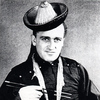TSONG KAPA, förgylld. Mongoliet, 1700-tal.
Repousseteknik. Bränn och kallförgylld. Sittande på tron i meditativ ställning (dhyanasana), händerna i dharmachakramudra på en upphöjd tron dekorerad med flankerande lejon, vajror samt gudomar. Svepande klädedräkt med fint dekorerade kanter. Bemålad mun och ögon. Sluten botten med dubbelvajra. Gjord i tre delar. Höjd 26,5 cm.
Provenance: Formerly in the collection of Danish Archaeologist, Ethnographer, Art Collector and Museum Director Werner Jacobsen (1914-79). For more information, see below.
Hatten lös, kvistar vid sidorna saknas. Bucklor, slitage.
Proveniens
Formerly in the collection of Danish Archaeologist, Ethnographer, Art Collector and Museum Director Werner Jacobsen (1914-79). Jacobsen studied archeology and participated 1938-39 in the Danish Royal Geografic Societys Expedition to Mongolia under the lead of Henning Haslund-Christensens.
During the years 1946-59 he lived in India and Nepal and acquired many pieces for National Museum in Denmark, The Royal Library, the Moesgård Museum and himself. He set up a scientific center in Kathmandu, Nepal and later in Denmark where he organized all the material and information he had gathered.
In 1940-45 he was employed the Danish National Museum, in 1961 he became Museum Director for the Etnografic Collection. 1963-78 he was the head of the information and educational Department at the Museum. The collection was acquired from Werner Jacobsen as a whole when he sold it to gather funds for new expeditions. Thence by descent to the present owner.
Litteratur
Werner Jacobsen published various literary and academic works such as; Bronzer fra Mongoliet, Köpenhamn, 1940, Some Observations on the Origin of Sino-sibirian Animal Bronzes, Köpenhamn 1941, Buddhsitisk Skulptur I Kina, Köpenhamn, 1941, Kabuki, det Japanska folks teater, Köpenhamn 1941, Todaerne, - en idisk bjergstamme, Köpenhamn 1949, Maleri fra Puri, Orissa, Indien, Köpenhamn 1961, Thailand, Arkeologi og Kunst, Köpenhamn 1961. Originale Bloktryk fra Nepal, Köpehamn, 1966, Asiatiske Akkorder, Köpenhamn 1965, Buddha og det modern menneske, Köpenhamn, 1970, Kunsten, kunstneren og inderen, Köpenhamn, 1970, Den hvide mans byrde, Köpenhamn, 1970, Hvad er den egentlige virkelighed, Köpenhamn, 1976, Den hvide gud, Köpenhamn, 1973.
Övrig information
Tsongkhapa, also known as Je Rinpoche, was born in the Amdo region of Tibet in 1357. He was a highly respected Buddhist scholar and is credited as being the founder of the Gelug Buddhist sect, known as the "Yellow Hat" sect, one of the most powerful and widespread in the Buddhist religion.
Tsongkhapa is revered as an incarnation of the bodhisattva Manjushri, and was reported to have seen and conversed with the deity from a young age. The current bronze example can be seen holding the stems of lotus flowers supporting a sword and book, which are the prime attributes of bodhisattva Manjushri.















































